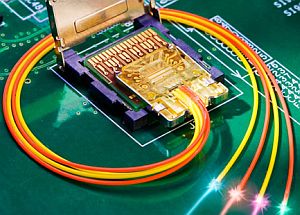Data over light -Intel's latest achievement
Intel’s latest technology is aiming at increasing the bandwidth by using light to carry data. When we migrated from USB 1.0 to 2.0 and currently 2.0 to 3.0, we can see the difference between the speed of data transfer and the convenience we get by the fast transfer rate.

Now, Intel claims to have done even better with the new technology, namely “light Peak”. We are already using the fiber optic technology and now Intel is aiming to use this technology at the user level 3.0 and these technologies are almost complimentary and not in competition with each other.
Intel has given the name ‘Light Peak’ for the optical cable connectivity which has a high transfer speed. Intel gave the demonstration of this new technology for the first time in 2009 as a prototype which was fully functional. The quality of signal was tested on a 30-meters cable and then on a 100-meter cable and amazingly, both showed the same quality. The cable used in light peak is also very durable and are very least affected by noise or disturbances. Intel claims that even if you tie a knot, the cable will still work.
At the basic level it can be thought as two optic cables which carry downstream and upstream traffic separately; each one dedicated to one task of either upstream or downstream. This technology is not protocol dependent; it is just a physical medium of transfer. This means we now don’t have to create new protocol stacks for the task. Till date, the protocols are designed to carry 10 Gbps data. We can transfer a full blue ray disc in just about 30 seconds. It also facilitates connecting of multiple devices working on multiple protocols. This technology will be highly helpful in laptop devices and other mobile devices making them more compact and more efficient. You can imagine the technology as a single cable coming out of your laptop connecting to power source, printer, or any other peripheral device.
Optic fiber cables don’t have a finite bandwidth and Intel has promised a 100Gbps speed by the end of this decade. The system consists of a chip which controls and an optical module which is in charge of converting electrical signals to light. The chip also performs the reverse of the function. Thus, the other functionality remains the same .With mass production, the cost of production is expected to decline.
The major reason for migrating to the light medium is that it is least affected by the noise and other interference and is also considerably fast having infinite amount of bandwidth.
Till now light peak doesn’t seem to have a good scope as to the power efficiency consideration and the constant light generation needed. Another major problem is to process the data at this much high speed by the devices for example, A CD drive will not be able to write the data at this much speed .
Surely the solutions of all of the above problems will be found soon to implement this lightning fast technology.

















